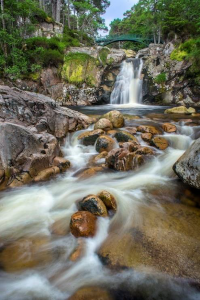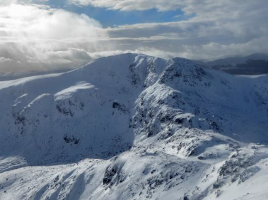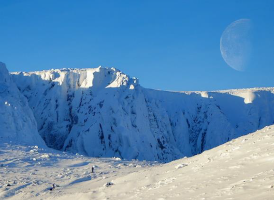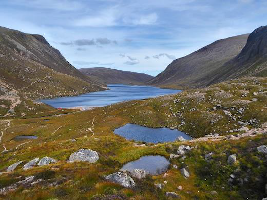Photography in the Hills
Mike Duguid
Those who know me from hillwalking clubs will be aware I'm a keen outdoor photographer, and I'll share a few thoughts here on some abstract attributes that I think can help acquire good shots, while mostly avoiding the well-trod discussions on technical or artistic aspects. These are preparation, persistence, and vigilance.
 Those who've walked with me may be familiar with my tendency to suddenly leave the chosen route, haring away off-trail in some unusual direction. It's not as random as it may seem, I usually research a trip beyond the basics of the route. Preparation: Are there detours of interest nearby, perhaps waterfalls, caves or monuments, a viewpoint that will look down a gorge, a ridge that will catch the morning sun at a certain time?
Those who've walked with me may be familiar with my tendency to suddenly leave the chosen route, haring away off-trail in some unusual direction. It's not as random as it may seem, I usually research a trip beyond the basics of the route. Preparation: Are there detours of interest nearby, perhaps waterfalls, caves or monuments, a viewpoint that will look down a gorge, a ridge that will catch the morning sun at a certain time?
For researching locations beyond OS or photographic sites like Flickr we have e.g. Geograph.org.uk which maps and photographs each square of the UK, often with useful local knowledge; photographer's ephemeris plots daylight against a 3D landscape on any day of the year, informing when a location will be lit nicely.
The Falls of Garbh Allt are in the shade much of the day, but I knew it would be in good light in the afternoon when we'd be passing, so I'd taken a tripod for a long exposure. I ran ahead of the walking group I was with, to get in position and get a clear shot before they arrived.
 Persistence is the next attribute. I apologise to those who've suffered alongside my determination to 'see more' during adverse conditions: an unfortunate tumbling rucksack climbing a slope above Coire Garbhlach; quartering drenched bog below Schiehallion in search of a cave; freezing in a white-out waiting for the skiers to align. Sometimes successful, sometimes not, but sticking around or slogging the extra mile often leads to 'the shot'. On Ben Vorlich, the sun suddenly appeared after being in cloud all the way up. Another group summitted then left to head down immediately but they'd seen nothing but a grey void, because they didn't wait a short period.
Persistence is the next attribute. I apologise to those who've suffered alongside my determination to 'see more' during adverse conditions: an unfortunate tumbling rucksack climbing a slope above Coire Garbhlach; quartering drenched bog below Schiehallion in search of a cave; freezing in a white-out waiting for the skiers to align. Sometimes successful, sometimes not, but sticking around or slogging the extra mile often leads to 'the shot'. On Ben Vorlich, the sun suddenly appeared after being in cloud all the way up. Another group summitted then left to head down immediately but they'd seen nothing but a grey void, because they didn't wait a short period.
 There is much more to most hills than the basic 'walkhighlands' route. Gullies, woods, howffs, snow patches, old ruins. It takes persistence to get to know the best angles, the nooks and crannies, to return many times and in many seasons to explore hills already summitted.
There is much more to most hills than the basic 'walkhighlands' route. Gullies, woods, howffs, snow patches, old ruins. It takes persistence to get to know the best angles, the nooks and crannies, to return many times and in many seasons to explore hills already summitted.
It took a few trips exploring off the beaten path on the mountain plateaus to find places of deep snow accumulation, then heading into summer monitor the snow cover using satellite resources, and finally dropping everything to head up at the right moment to snap this snow tunnel.
The next attribute is vigilance. Constantly paying attention to the light moving on the hillside, to the sky above and the ground around - perhaps for a glimpse of wildlife, perhaps just noting that in a few minutes the river bend will align with the distant peak, maybe a slight climb of a bank allows better geometry of a lochan below. I'm often surprised how many people are just paying attention to a small tunnel of trail in front of their feet, and don't see the eagle above, or miss the old ruin behind the trees.
When an opportunity arises, I find it important that my camera is instantly accessible and not buried in the rucksack; how many fabulous photographic opportunities must be missed by hindered access? I have a small shoulder pouch on my rucksack strap allowing me to reach my camera in an instant, and I can take a photo on the move barely breaking stride.
 |
 |
 |
The adder was glanced by the trail, and having the camera to hand quickly, and the settings already correct to not disturb an animal (auto-focus light switched off) helped get this close-up. |
The stripe of light on Devil's Point only lasted a moment before the hillside fell dark again. |
On an early morning ascending Lochnagar I noticed the moon setting towards the crags, and an unusual shot was secured with a very long zoom, good timing, and the ideal distant position. |
Sometimes, 5 minutes or 5 metres can make the difference. While the group lunched under the Shelter Stone, I drank up my tea, headed outside and found a vantage point overlooking Loch Avon, then side-stepped to find a better alignment allowing some crags on the right to enter the frame.


Finally, I'd like to quash the purist idea that not processing photos is a superior form of photographic endeavour. Few cameras can capture the full dynamic range of the human eye; a chip worth a fiver decides whether to expose the sky or ground and invariably the "camera does lie" when there is strong contrast. Shooting raw files, and a basic tweak of dark and light, has the following photos from within a howff on Beinn a Bhuird, resembling what was really seen: I could see the clouds in the sky, but also the detail in the rocks nearby, neither bleached white or invisible in darkness. (Hopefully the subtle difference shows in print, left unprocessed, right processed)


I hope you've enjoyed a few of the shots and find the thoughts on process useful. I'm always happy to talk photography if we meet on a walk, and it's always great to see other photos from out in our hills; if you use FaceBook please consider sharing some on the NEMT page.
all images © M Duguid. Resolution reduced for website
NEMT Front
Page | Previous Page | Volume
Index Page | Next Page | Journal
Index Page
Please let the webmaster know
if there are problems with viewing these pages or with the links they
contain.
 Those who've walked with me may be familiar with my tendency to suddenly leave the chosen route, haring away off-trail in some unusual direction. It's not as random as it may seem, I usually research a trip beyond the basics of the route. Preparation: Are there detours of interest nearby, perhaps waterfalls, caves or monuments, a viewpoint that will look down a gorge, a ridge that will catch the morning sun at a certain time?
Those who've walked with me may be familiar with my tendency to suddenly leave the chosen route, haring away off-trail in some unusual direction. It's not as random as it may seem, I usually research a trip beyond the basics of the route. Preparation: Are there detours of interest nearby, perhaps waterfalls, caves or monuments, a viewpoint that will look down a gorge, a ridge that will catch the morning sun at a certain time?
 Persistence is the next attribute. I apologise to those who've suffered alongside my determination to 'see more' during adverse conditions: an unfortunate tumbling rucksack climbing a slope above Coire Garbhlach; quartering drenched bog below Schiehallion in search of a cave; freezing in a white-out waiting for the skiers to align. Sometimes successful, sometimes not, but sticking around or slogging the extra mile often leads to 'the shot'. On Ben Vorlich, the sun suddenly appeared after being in cloud all the way up. Another group summitted then left to head down immediately but they'd seen nothing but a grey void, because they didn't wait a short period.
Persistence is the next attribute. I apologise to those who've suffered alongside my determination to 'see more' during adverse conditions: an unfortunate tumbling rucksack climbing a slope above Coire Garbhlach; quartering drenched bog below Schiehallion in search of a cave; freezing in a white-out waiting for the skiers to align. Sometimes successful, sometimes not, but sticking around or slogging the extra mile often leads to 'the shot'. On Ben Vorlich, the sun suddenly appeared after being in cloud all the way up. Another group summitted then left to head down immediately but they'd seen nothing but a grey void, because they didn't wait a short period.
 There is much more to most hills than the basic 'walkhighlands' route. Gullies, woods, howffs, snow patches, old ruins. It takes persistence to get to know the best angles, the nooks and crannies, to return many times and in many seasons to explore hills already summitted.
There is much more to most hills than the basic 'walkhighlands' route. Gullies, woods, howffs, snow patches, old ruins. It takes persistence to get to know the best angles, the nooks and crannies, to return many times and in many seasons to explore hills already summitted.






